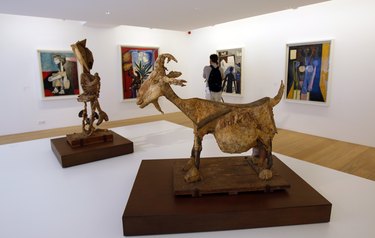
Pablo Picasso was a prolific artist, producing both classical and innovative works, including painting, prints, ceramics, sculpture and experimental forms. Born in Spain in 1881, Picasso had a career that spanned 70 years, a long career that allowed him the opportunity to develop and experiment with his art. He helped developed Cubism, an abstract painting technique. Picasso used color and emotional expression in his work.
Angles and Squares
Video of the Day
Along with Georges Braque, Picasso created a form of abstract art known as cubism. Rather than painting a realistic image, Picasso created multiple viewing angles in one image with the intent to show more than first meets the eye, inviting the viewer to move around and look the image from different angles. The cubes and squares throughout cubism imitate the forms that the images would have in different dimensions. While Picasso's cubist work was first criticized by the critics, the style influenced modern and abstract artists.
Video of the Day
Color and Emotion
Use of color is another well-known aspect of Picasso's art, which he used to convey his feelings and emotions as well as to form images. For example, he used dark tones and shades of grey to convey the trials of war, blues to depict the plight of social outcasts, and reds to convey the delight and joy of circus performers. Picasso's portrayal of personal feeling was unusual and groundbreaking, as artists had traditionally focused on portrayal of images rather than a depiction of their emotions. While Picasso's color choice and how he used color changed throughout his career, it remained a key part of his art.
Drawing on Mythology
Although Picasso was an innovator of abstract art, he also created traditional paintings. After World War I, Picasso moved more toward classical painting techniques, spending less time creating cubist and abstract paintings. He drew on classical fantasy and mythological characters and themes such as nymphs, minotaurs and centaurs. Inspired by the birth of his son, he also created works depicting the calming influence of motherhood.
Experiments and Explorations
While Picasso saw himself as painter first, he also worked with other media, including creating sculptures such as "Woman's Head." He designed ceramics such as the Madoura collection. Picasso explored printmaking techniques, producing over 134,00 prints, engravings and illustrations. Working with Georges Braque again, Picasso collaborated in inventing collage by pasting paper on canvas as a way to create an arrangement of symbols to refer to objects, rather than an image as a window to the world. He used this technique to create works like "Playing Card and Glass." In addition, Picasso produced thousands of stage designs. His long life and career allowed him to explore and experiment in his art, redefining himself as well as inspiring other artists.
- Pablo Picasso, Paintings, Quotes, and Biography: Pablo Picasso and his Paintings
- The Art Story: Pablo Picasso Synopsis
- The Metropolitan Museum of Art: Pablo Picasso (1881–1973)
- The Museum of Modern Art: Collage
- Artnet News: The Story Behind Picasso Ceramics
- Museum of Modern Art: Focus: Picasso Sculpture